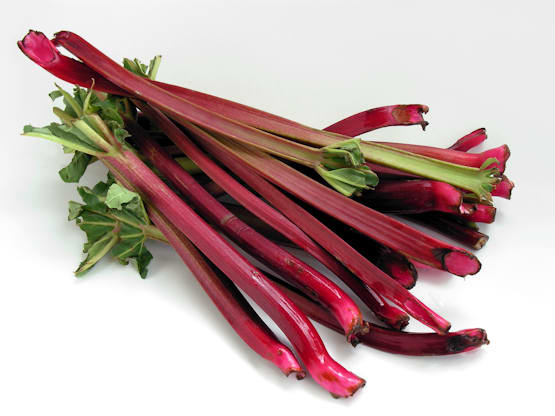
The word is out in culinary circles that rhubarb is making a comeback, but as far as I’m concerned it never went out of style. I cook with rhubarb whenever I see it in the stores, starting around late April, when it is easy to find the crisp, red stalks at farmers’ markets and even in most supermarkets. My mother made stewed rhubarb every week (in off seasons she used the frozen boxed kind), so it is either in my genes or deeply implanted in the food-memory part of my brain because It was one of her regular go-to side dishes (alternating with homemade applesauce) when she was at a loss for a vegetable.
In fact, rhubarb is a vegetable; it looks like red celery. So even though we usually cook it with sugar to temper its acidity, I suppose my mother could rightfully conclude that we were eating our vegetables. She made stewed rhubarb with much less sugar than most recipes call for (as I do to this day), but I don’t think she was thinking about nutrition. There were too many other good reasons to make it. Like, stewed rhubarb is incredibly fast and easy to prepare. It goes with almost any meat you cook, but because of its astringent nature it works particularly well with rich ones such as roast chicken, duck and lamb. It is also a sensational side dish for grilled or roasted salmon, arctic char, tilapia, cod and halibut. You can serve stewed rhubarb plain but it also benefits from a small amount of flavoring ingredients such as orange or lemon peel or spices such as cinnamon, nutmeg or ginger. It lasts for a week in the refrigerator. It’s scrumptious.
Do you need more reasons? Here’s another: rhubarb is much more versatile than you might think. It’s used mostly for desserts – think rhubarb crisp and strawberry-rhubarb pie. Even plain old stewed rhubarb can be dessert if you spoon some on top of cheesecake or top it with whipped cream or even mix some into whipped cream to make a “fool.”
But you can also take advantage of rhubarb’s tart quality for sauces and side dishes at dinner. Make a tangy chutney to serve with grilled beef or chicken. Or sauté diced rhubarb with onion, celery and garlic, sprinkle with a few drops of Balsamic vinegar and serve as a garnish for salmon or other rich fish.
The recipe for stewed rhubarb is the one I’ve used for years and years. I usually don’t include the optional ingredients because I like the taste of rhubarb on its own, but feel free to embellish. If you have a small amount left over, mix in some chicken stock and use it as a glaze for roast chicken or turkey.
The recipes for rhubarb crisp and rhubarb chutney are fairly easy; crisp is always delicious with a plain flavored ice cream that doesn’t detract from the fruit. The chutney can be stored in the refrigerator and lasts for a week.
The last recipe for Strawberry-Rhubarb Pie shows the happy marriage of two spring ingredients, one sweet, the other, more assertive. Your house will smell divine when you make this dish. It’s a fabulous spring Shabbat dessert; for a meat meal use an all-shortening crust and switch to margarine in the pie filling.
WARNING: Do not eat rhubarb leaves, which contain poisonous oxalic acid. The stalks are perfectly safe.

Ronnie Fein has been a freelance food and lifestyle writer since 1980. She currently writes regular features for the food and community sections of daily newspapers and has written articles for Newsday, Cook’s Illustrated, Consumer’s Digest, Connecticut magazine, and many other publications. She operates the Ronnie Fein School of Creative Cooking in Stamford, Connecticut and is the author of three cookbooks, the most recent is Hip Kosher (DaCapo, 2008).
The words of this author reflect his/her own opinions and do not necessarily represent the official position of the Orthodox Union.
